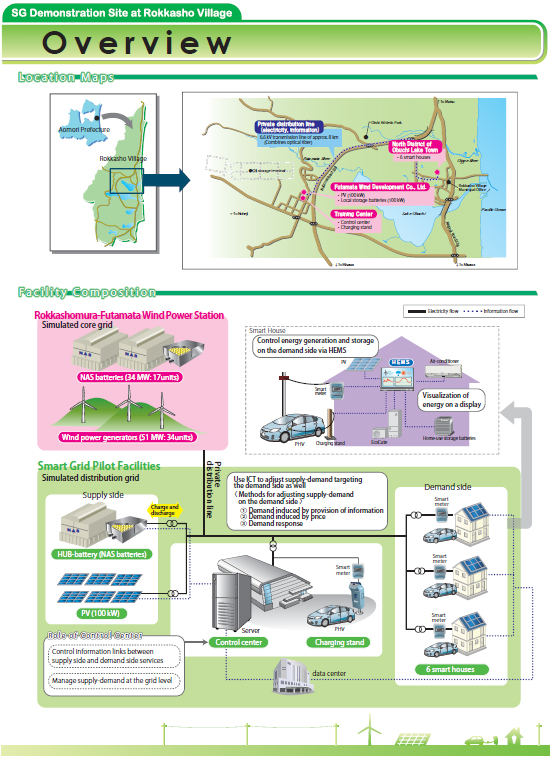Information contained in this news release is current as of the date of the press announcement, but may be subject to change without prior notice.
September 15, 2010
Tokyo September 15, 2010 --- Japan Wind Development Co., Ltd. (TSE MOTHERS: 2766, “JWD”), Toyota Motor Corporation (NYSE:TM/TSE:7203, “Toyota”), Panasonic Electric Works Co., Ltd. (TSE:6991, “Panasonic Electric Works”) and Hitachi, Ltd. (NYSE:HIT/TSE:6501, “Hitachi”) announced the start of a smart grid demonstration project on September 16, 2010 in Rokkasho Village, Aomori Prefecture, Japan. The project aims to verify technologies that allow for the efficient use of energy toward the achievement of a low-carbon society. The project will use only renewable energy sources, such as the world’s first wind power stations with dedicated large-capacity batteries and photovoltaic power-generation systems.
Building smart grids requires meeting the electricity supply conditions (power sources and transmission lines) and communications infrastructure of each specific country and region, as well as introducing such elements as renewable energy generation facilities, electric vehicles and plug-in hybrid vehicles, storage batteries, EcoCute (an electric water heating and supply system) and heat storage units. Currently, possibilities in new electricity distribution methods and vast advances in information and communications technology (ICT) are raising the prospect of a shift from today’s conventional supply-demand adjustment approach to one that optimizes both supply and demand.
JWD, Toyota, Panasonic Electric Works and Hitachi have built an isolated grid--an electricity network independent from the main grid--in Rokkasho Village, which has favorable conditions for wind power generation and has Japan’s largest wind power generation capacity. The companies will work jointly to develop and demonstrate technologies for optimizing supply and demand effectively.
Planned timeframe: September 2010 to July 2012 Location: Oaza Obuchi, Rokkasho-mura, Kamikita-gun, Aomori-ken (Refer to overview)
The four companies have built an isolated grid that emits no CO2 by using the world’s first wind power stations with dedicated large-capacity storage batteries. Aiming for quick commercialization of the system in Japan and overseas, the demonstration project will integrate supply-side electricity generation using renewable energy with demand, while conducting energy management for the entire area concerned to demonstrate optimization of energy efficiency.
Specifically, the project will verify the more-efficient use of energy by creating scenarios that can only be demonstrated with an isolated grid. The scenarios will be based on assumptions regarding electricity conditions (power sources, demand and supply-demand balance) and regional conditions (remote island, weather and other specific conditions) in target countries and regions (Japan, Europe, emerging nations, resource-rich countries, etc.).
JWD, Hitachi will develop a monitoring and control system to link overall supply and demand, power generation and energy storage. (The control center is located at the training center of EOS Engineering & Service Co., Ltd.)
Six smart houses have been built in the North District of Obuchi Lake Town, a residential and commercial subdivision in Rokkasho Village, to collect real household environment data for testing.
A dedicated private distribution line has been installed between the Rokkashomura-Futamata Wind Power Station and the North District of Obuchi Lake Town
Three types of home energy management systems (HEMS) are installed in smart houses.
Smart meters will be installed in smart houses and other power consumption locations.
To adjust supply and demand in the grid, a storage battery has been installed as a “HUB-battery” for local use
| Main members |
|
| Project adviser |
|
| Cooperation companies |
|
| Municipal cooperation |
|
JWD (Japan Wind Development Co., Ltd.), headquartered in Tokyo, Japan, owns and operates 184 wind turbines that generate electricity sold to local utility companies and other industrial users. JWD is aggressively investing in wind resources throughout the world. JWD's global network of offices and wind power plants has expanded rapidly in the last decade. Furthermore, JWD is focusing on obtaining technological knowledge through experimental projects with the most-efficient control systems for power demand/supply adjustment. JWD intends to apply intellectual properties from the Rokkasho Village demonstration project to renewable energy projects globally. For more information on the company, please visit the company's website at http://www.jwd.co.jp/.
Founded in 1937, Toyota City, Aichi Prefecture-based Toyota Motor Corporation is one of the largest automakers in the world, producing a full range of vehicles, from minivehicles to large trucks. Global sales of its Toyota and Lexus brands, combined with those of Daihatsu and Hino, totaled 7.2 million units for the year ended March 31, 2010. Toyota is a leader in environmentally friendly vehicles, with cumulative global sales of its hybrid vehicles marking 2.7 million units as of the end of August 2010. As of the end of March 2010, besides its facilities in Japan, Toyota has 51 manufacturing companies in 26 countries/regions. Toyota employs about 320,000 people worldwide (on a consolidated basis), and markets vehicles in more than 170 countries/regions.
Panasonic Electric Works Co., Ltd. (PEW) traces its roots to the company started in 1918 by Konosuke Matsushita. This forerunner of PEW started out by producing an enhanced attachment plug. Thereafter, PEW expanded the scope of its business beyond electrical construction materials (lighting products, information equipment and wiring products), home appliances, building products, electronic materials and automation controls, all of which showcase its technological strengths. Based in Osaka, Japan, the company recorded consolidated net sales of 1.45 trillion yen (US$15.6 billion) for the year ended March 31, 2010. The company's shares are listed on the Tokyo and Osaka stock exchanges. For more information on the company, please visit the company's website at http://panasonic-electric-works.net/.
Hitachi, Ltd., (NYSE: HIT / TSE: 6501), headquartered in Tokyo, Japan, is a leading global electronics company with approximately 360,000 employees worldwide. Fiscal 2009 (ended March 31, 2010) consolidated revenues totaled 8,968 billion yen ($96.4 billion). Hitachi will focus more than ever on the Social Innovation Business, which includes information and telecommunication systems, power systems, environmental, industrial and transportation systems, and social and urban systems, as well as the sophisticated materials and key devices that support them. For more information on Hitachi, please visit the company's website at http://www.hitachi.com.
